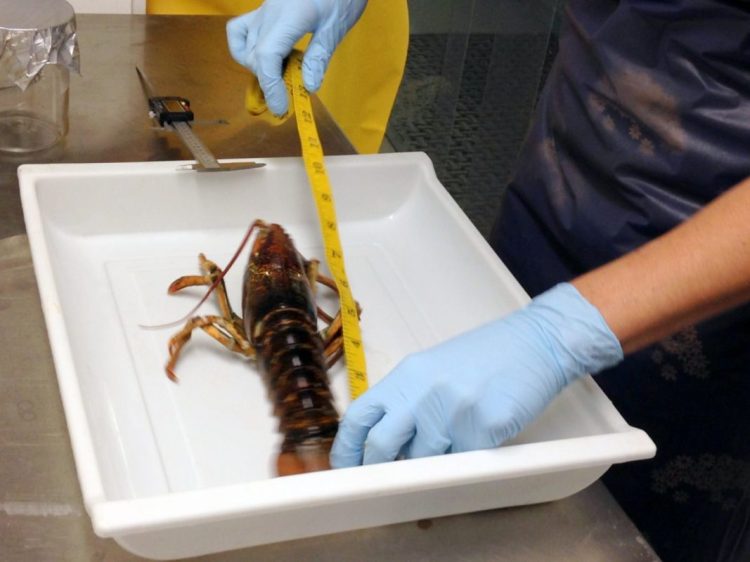ELLSWORTH — Scientists at the Bigelow Laboratory for Ocean Sciences have discovered that microplastic pollution of the ocean is having an impact on Maine lobsters.
In a study published last month, a team of researchers reported its findings that microplastic fiber pollution in the ocean affects larval lobsters at each stage of their development. According to the report published last month in the Marine Pollution Bulletin, the tiny plastic fibers affect the animals’ feeding and respiration and could even kill some larvae.
The lead author of the report was Madelyn Woods, a recent Bigelow Laboratory intern and former researcher at the Shaw Institute in Blue Hill. In 2014, the Shaw Institute conducted a pilot study focused on microplastics in lobsters as well as in oysters, herring and mackerel and later, a study on ingestion of microplastics by mussels.
The Bigelow study was “designed to study the impact of microplastics on the lobster’s life cycle,” Susan Shaw, executive director of the Shaw Institute, said in a telephone interview last weekend. This summer, she said, researchers from the institute will begin collecting samples of adult lobsters for “a larger study of what’s in the food we’re eating.”
The Bigelow Laboratory study had a different focus.
“In today’s ocean, organisms are exposed to so many environmental factors that affect how many make it to the next stage of life,” said Paty Matrai, a study author and senior research scientist at Bigelow Laboratory for Ocean Sciences. “Lobsters play a fundamental role in the Gulf of Maine ecosystem as well as the state’s economy, and it is important that we understand how pollutants impact their development.”
Young lobsters grow to adulthood through four distinct developmental stages, and the researchers found that the physiology of each stage determined how the animals interacted with plastic fibers. Although the youngest lobsters didn’t eat them, they were plagued by fibers that accumulated under the shells that protect their gills. When the larvae were exposed to high levels of fibers in the laboratory, the youngest larvae were the least likely to survive.
Older larvae that were more mobile and agile did not accumulate fibers under their shells, but they did ingest the particles and keep them in their digestive systems. That could pose problems for lobster larvae coming of age in the ocean, the study found. Fresh plastics often leach chemicals, and their surfaces can foster potentially toxic sea life.
“Plastic particles have been found in almost every animal in the ocean,” said David Fields, another study author and a senior research scientist at Bigelow Laboratory. “If an animal can fit something in its tiny little piehole, it’s probably going to – and that can have repercussions for the animal and potentially for the food web.”
Microplastic fibers enter the ocean from sources including wastewater, and they can also be created in the ocean as larger materials degrade. Plastics tend to float at the surface, where they are exposed to sunlight and wave action that eventually break them down into small particles.
Though the levels of microplastic fibers in coastal Maine waters are relatively low, they can still present a serious challenge to the animals that encounter them. In a 2010 study, researchers from the Shaw Institute found 17 plastic particles per liter of water samples taken from around Blue Hill Bay.
Some animals are predisposed to encounter any fibers that are in the water, researchers say. Because microplastic fibers tend to remain at the ocean’s surface, animals that inhabit surface waters – such as larval lobsters – are more likely to come into contact with them.
Microplastic pollution isn’t confined to the upper levels of the water column.
According to Shaw, the earlier mussel feeding study offered “dramatic” evidence of microplastics’ impact, amounting in some instances to as much as 50 percent of the bivalves’ diet.
“Even relatively low levels of plastics can be harmful for the animals that encounter them, and where an animal lives in the water column can amplify the problem,” Fields, the Bigelow researcher, said. “A lobster larva that eats a plastic fiber is just like us eating a candy wrapper – it’s not great, but it will probably just pass though. But if all you’re eating is candy wrappers, it’s certainly going to have other repercussions for your health.”
Send questions/comments to the editors.



Success. Please wait for the page to reload. If the page does not reload within 5 seconds, please refresh the page.
Enter your email and password to access comments.
Hi, to comment on stories you must . This profile is in addition to your subscription and website login.
Already have a commenting profile? .
Invalid username/password.
Please check your email to confirm and complete your registration.
Only subscribers are eligible to post comments. Please subscribe or login first for digital access. Here’s why.
Use the form below to reset your password. When you've submitted your account email, we will send an email with a reset code.